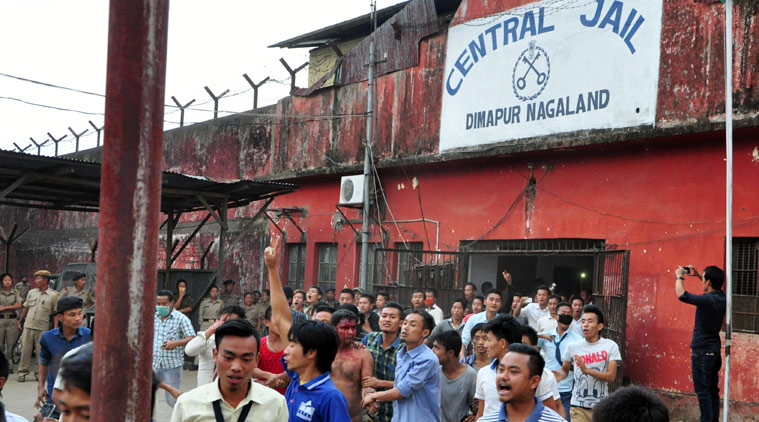Ajeet Kumar Rai, 25, was a rifleman with the 39th Assam Rifles and was posted at the battalion’s camp at Mimbung in eastern Mizoram.
By Adam Halliday
Aizawl, May 19 : The Mizoram police has told the Ministry of Defence the 25-year-old Assam Rifles rifleman who died from gunshot wounds to the head while on sentry duty last August committed suicide and was not murdered as his relatives are alleging.
“The deceased had committed suicide due to depression arising from family and work since investigation could not revealed (sic) concrete evidences of murder and conspiracy,” concludes a report submitted by Champhai district SP R P Meena to Jay Prakash, Additional Private Secretary to the Defence MoS.
Ajeet Kumar Rai, 25, was a rifleman with the 39th Assam Rifles and was posted at the battalion’s camp at Mimbung in eastern Mizoram.
His elder brothers Ajai Kumar Rai and Atul Kumar Rai (Atul is also a rifleman with the Assam Rifles and who was posted in Lunglei, also in Mizoram, at the time of his brother’s death) allege Ajeet was murdered by his colleagues after an altercation. They officially filed an FIR on September 8 in Champhai town.
The police at Ngopa, which hosts the nearest police station from Mimbung, were meanwhile unable to examine the body immediately after the tragedy since the Assam Rifles had brought it to Aizawl for post-mortem and for it to be dispatched home to UP by flight the following day. Police had subsequently registered a case of unnatural death and began investigations.
The SP’s report says the Investigating Officer collected the rifleman’s service rifle, an AK-47, as well as 27 live ammunition in it, two empty cartridges and one live ammo still loaded in the gun’s chamber.
The dead man’s finger-prints were also lifted, it said, adding these were among the items forwarded to the Forensic Science Laboratory in Aizawl along with photos of the dead body taken from different angles (the report however says “chance finger prints could not be developed because of oily surface of the firearm”).
The IO examined Rai’s two elder brothers, three men they accused of killing the rifleman as well as more than 20 personnel posted at the Mimbung camp.
Ajeet’s mobile handset was also seized and a Call Detail Report also obtained from which police found Ajeet had spoken to his ex-wife Vineeta Rai just before he died, the report says.
Vineeta was contacted over phone and she told police Rai had told her he wanted to resign from service because of an argument he had had with this colleagues, and mentioned his elder brothers were arranging for him to be married to another woman soon, the report says.
The SP’s report says Vineeta told police Ajeet told her “his brothers were arranging a marriage with another girl he did not want as he still loved her” and also that Ajeet and Vineeta divorced because of pressure from his brothers.
The Assam Rifles had from the beginning said Ajeet killed himself because of problems at home while his family maintained they suspected murder because Ajeet had told them on the day of his death that he had been in a serious argument with his colleagues, claiming some of his colleagues also corroborated their suspicions.
By Adam Halliday
Aizawl, May 19 : The Mizoram police has told the Ministry of Defence the 25-year-old Assam Rifles rifleman who died from gunshot wounds to the head while on sentry duty last August committed suicide and was not murdered as his relatives are alleging.
“The deceased had committed suicide due to depression arising from family and work since investigation could not revealed (sic) concrete evidences of murder and conspiracy,” concludes a report submitted by Champhai district SP R P Meena to Jay Prakash, Additional Private Secretary to the Defence MoS.
Ajeet Kumar Rai, 25, was a rifleman with the 39th Assam Rifles and was posted at the battalion’s camp at Mimbung in eastern Mizoram.
His elder brothers Ajai Kumar Rai and Atul Kumar Rai (Atul is also a rifleman with the Assam Rifles and who was posted in Lunglei, also in Mizoram, at the time of his brother’s death) allege Ajeet was murdered by his colleagues after an altercation. They officially filed an FIR on September 8 in Champhai town.
The police at Ngopa, which hosts the nearest police station from Mimbung, were meanwhile unable to examine the body immediately after the tragedy since the Assam Rifles had brought it to Aizawl for post-mortem and for it to be dispatched home to UP by flight the following day. Police had subsequently registered a case of unnatural death and began investigations.
The SP’s report says the Investigating Officer collected the rifleman’s service rifle, an AK-47, as well as 27 live ammunition in it, two empty cartridges and one live ammo still loaded in the gun’s chamber.
The dead man’s finger-prints were also lifted, it said, adding these were among the items forwarded to the Forensic Science Laboratory in Aizawl along with photos of the dead body taken from different angles (the report however says “chance finger prints could not be developed because of oily surface of the firearm”).
The IO examined Rai’s two elder brothers, three men they accused of killing the rifleman as well as more than 20 personnel posted at the Mimbung camp.
Ajeet’s mobile handset was also seized and a Call Detail Report also obtained from which police found Ajeet had spoken to his ex-wife Vineeta Rai just before he died, the report says.
Vineeta was contacted over phone and she told police Rai had told her he wanted to resign from service because of an argument he had had with this colleagues, and mentioned his elder brothers were arranging for him to be married to another woman soon, the report says.
The SP’s report says Vineeta told police Ajeet told her “his brothers were arranging a marriage with another girl he did not want as he still loved her” and also that Ajeet and Vineeta divorced because of pressure from his brothers.
The Assam Rifles had from the beginning said Ajeet killed himself because of problems at home while his family maintained they suspected murder because Ajeet had told them on the day of his death that he had been in a serious argument with his colleagues, claiming some of his colleagues also corroborated their suspicions.














